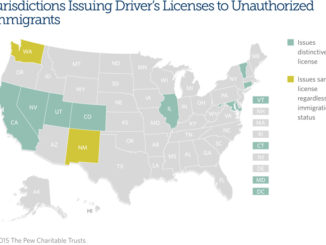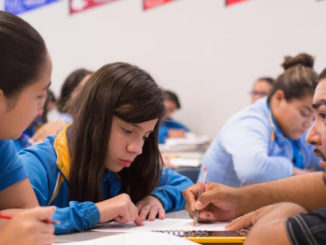
by
Olympia Kingdom and her father had a debate as she went to college. Kingdom Ezenwa, a pharmacy technician who emigrated from Nigeria in 2001 with his wife and children, wanted his oldest daughter to become a pharmacist. She wanted to teach. Olympia won out. The University of North Texas at Dallas graduate, who came to the United States at age five, will start teaching in the Grand Prairie school district this fall.
This is the type of fight that families should have: Parents discussing paths for their children, and their children developing visions of their own. We should remember these discussions occur in families new to America, too. The heated debate over immigration can obscure the fact that families like the Kingdoms want to become part of their new country.
“Going to college felt like a big responsibility,” Olympia told me over coffee one day this spring at UNT-Dallas. “I was the first in my family to go. I was happy to go. It was for the greater good.”
Olympia’s college path was certainly good for her and her family. She hopes her younger sister will follow her lead. And her success is equally good for our nation.

Immigrants broaden our talent pool, helping supply the teachers, doctors and leaders we need. A Bush Institute report shows that immigrants accounted for 45 percent of new workers in the U.S. over the last decade. That’s a compelling reason to discover the strategies and policies that help immigrants, especially students from immigrant families, use their skills and move into the mainstream. The right strategies and policies will have a larger beneficial effect.
One of those effective strategies starts at home with active parents. In Olympia’s case, her parents had been very involved with her education, although in different ways. “My mom went to all my school functions,” she smiled in explaining. “She was the face people saw.”
Olympia described her dad as not being involved with school activities but the “voice for education behind the scenes.” He would ask why she was making a 90 when some students were making a 100.
Despite their different roles, Olympia’s parents were advocates for attending and finishing college. That is a huge asset, especially with the financial, cultural and linguistic challenges that immigrant students face as they attempt to move into the broader culture.
Small, community programs can be effective
What happens with students if familial support is missing? Programs that train parents to advocate for their children, such as The Concilio, are one alternative.
The Dallas-based organization uses research-based practices to train parents, many of them Hispanic mothers and fathers, to become advocates for their children’s education. Avance also connects young parents to their children’s education, focusing on parenting strategies, early childhood education and literacy. And some Dallas schools have parent liaisons, who, if trained properly, provide an invaluable connection between the classroom and the living room.
The beauty of such organizations and efforts is they don’t require massive investments or a big-deal federal program. They instead provide a community-based way to involve parents, exemplifying how strong local institutions can play a mediating role in society. In this case, dealing directly with the issue of immigration.
Still, parenting programs can’t reach all students, which is why mentoring initiatives and mentoring relationships are equally crucial. Mentors have come up repeatedly in interviews I have conducted with immigrant students who are the first generation in their families to attend college.
Eraquio Garcia, who just finished his second year at the University of Texas at Austin, describes how two of his teachers at Thomas Jefferson High School mentored him. “Mr. Pacheco and Ms. Cadigan were big influences,” he recalled as we talked about his experiences. “They were my calculus and history teachers, and they explained what was expected of me. They would ask me questions and push me forward.”
Something must have worked. Eraquio was his class president, prom king, and one of the top students in his graduating class.
Garcia’s parents came from Mexico, but he was born and raised in Texas. In going to college, he has had to step away from the family structure, although he retains strong ties. “We are family based,” he explained. “I was the first to go to college, and they wanted me to stay close. Going to UT feels like a thousand miles away for them.”
Finding mentors for immigrant students is a crucial way for universities to help students who feel they don’t belong on a college campus. The lack of belonging is common among first-generation college students, particularly students whose families are new to America. That reality has come up repeatedly in interviews with immigrant students in college.
How non-profits can help
Private organizations and non-profits can help them make the transition, too. Over the last few years, I have dealt numerous times with ScholarShot while reporting on immigrant students. The Dallas-based non-profit serves students who are at risk of not finishing college. And 100 percent of the organization’s most recent classes have been first-generation students with serious financial needs. Dan Hooper, ScholarShot’s executive director, says that 65 percent of those students come from immigrant families.
ScholarShot staff members form mentoring relationships with the organization’s scholars since many of the staff members were first-generation students themselves. They work with students to develop their academic plans, which might include first attending community college. They also serve as advocates, asking why the students might drop a course or take on debt, helping students keep their loans manageable.
Garcia is a ScholarShot student. As we talked this summer, the finance major described how ScholarShot “helps me stay organized and on task. My (ScholarShot) facilitator emails me, asking me about particular classes.” He was asked this year to shepherd incoming ScholarShot students at UT.
Mayra Romero, who was born in the U.S. to Salvadoran immigrants, is also a ScholarShot product. The first in her family to graduate from college, the 25-year old finished Texas Women’s University in 2015. Today, she uses her nutrition degree in her work for a major food company.
ScholarShot helped her decide to first earn an associate’s degree at Mountain View College, which also houses Garza Early College High. “Dan and Melva were my resource,” she said, referring to Dan Hooper and Melva Franklin, ScholarShot’s program director. “I would call them when I had difficulty in class. I am still talking to them about starting an MBA.” (Interestingly, a mentor she first connected with as a 10-year old in West Dallas connected her with ScholarShot.)
The point here is that local institutions play a big role in helping immigrant students move into the larger mainstream. Most of our immigration debate is about what Washington can do. That is appropriate, but let’s not overlook the ways communities and their institutions can unravel this knotted-up problem.
Getting credit before entering college
The fact that both Olympia Kingdom and Mayra Romero attended Trinidad Garza Early College High at Mountain View College might not be a coincidence. The Dallas campus specializes in providing high school students the chance to graduate from 12th grade with some college credits.
The Dallas school district actually has exploded with early college offerings. Every Dallas ISD high school offers early college courses or International Baccalaureate.
Early college highs are becoming prominent in other districts as well. Dual-credit courses are becoming popular as a way for students to acquire skills for modern jobs as well as earn college credit before entering a traditional university or community college. The more students can rack up university credits while in high school, the more affordable college becomes.
The question is, will they become the education fad of the moment without delivering the quality of a real college curriculum? Edwin Flores, a Dallas school trustee, acknowledges that keeping early college high schools rigorous is part of the challenge. Yet he points out that the vast majority of the district’s early college high students are going on to a second year. And their scores as a whole trumped their DISD high school peers on the state’s end-of-course exams.
All this is good, very good. But the academic challenges that immigrant students face on the road to the mainstream start well before college. Equipping students with the skills to succeed in an early college high require the right strategies before then.
Do middle schools have teachers actually trained in math? Do elementary and secondary schools have principals who are effective leaders, able to guide their schools using research-based practices? And do schools use data as early as first grade to intervene with struggling students?
The right structure matters, especially when you consider the latest STAAR results. Scores for students in Dallas as well as across Texas declined significantly this year in reading. Scores on the state’s achievement tests also went down in all subjects, except for math. This translates into a simple reality: More young students are struggling to learn at the right grade level in necessary subjects such as reading.
Focusing on first generation students
What makes the University of North Texas at Dallas interesting is that it concentrates on students like Olympia Kingdom, who are the first in their family to attend or complete college. “They marketed the school as a first-generation place,” she recalled, pointing out that she learned about the picturesque southern Dallas campus while at Garza. “The school became like an extended family.”
Olympia was one of UNT Dallas’ 16 Presidential Jaguar Scholars. That gave her a full scholarship and connected her with a group of similar students. They met regularly, talked about college, volunteered together, and even went bowling.
UNT Dallas’ primary recruiting and service area is in the city of Dallas and inner-ring suburbs, according to Bob Mong, UNT Dallas’ president. The campus draws from the Dallas County Community College District, local school districts, and parochial and charter campuses. Serving first-generation college students “is our calling,” said Mong, who is also a former editor of The Dallas Morning News.
John Gasko, UNT Dallas’ education dean, believes that mission starts with creating both a sense of place and belonging on campus. From there, it includes faculty being expected to take one-on-one advising seriously, creating relevant degree plans with students, and helping them stick to their paths.
These are among the strategies that can help immigrant students use their talents. And we should keep identifying others since as many as one-third of American children are predicted to be living in immigrant families by 2050.
Those numbers can cause discomfort for some Americans. They feel that the country is losing its national identity. But identifying strategies that help immigrants have a chance at the middle class perhaps could offset that fear.
What if immigrants like Olympia Kingdom, Eraquio Garcia, and Mayra Romero actually strengthen our society? What if they are part of how America will be built over the next 50 years, just as immigrants from places like Eastern Europe, Ireland and Asia assimilated into American life in previous eras and made the U.S. a stronger, more innovative and culturally-rich country?
We should hope immigrant students today have access to smart education strategies and employment opportunities so they can become teachers, entrepreneurs and nutritionists. America is certainly going to need them.
William McKenzie is editor of The Catalyst: A Journal of Ideas from the Bush Institute. His email address is [email protected]. He can be reached on Twitter at @BillMcKenzie_




